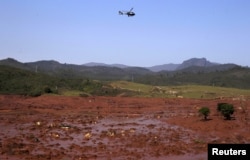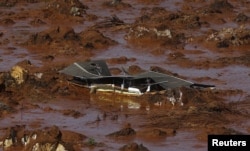The deadly collapse of a tailings dam last November at the Samarco mine, owned by Vale SA and BHP Billiton, was caused by drainage and design flaws, a report into Brazil's worst-ever environmental disaster showed Monday.
The 76-page report commissioned by the companies responsible for the spill, which killed 19 people, did not assign blame or highlight specific errors in corporate or regulatory practice.
Norbert Morgenstern, a geotechnical engineering professor who headed the investigation, repeatedly told reporters he could not answer their questions when quizzed on whether there was negligence or malpractice on the part of the companies involved.
A separate police investigation has accused Samarco of willful misconduct, saying the company ignored clear signs the dam was at risk of collapsing. Samarco denies any wrongdoing.
The report did, however, stress that a change in the dam's design between 2011 and 2012 resulted in less efficient drainage resulting in saturated sand in the dam, without which liquefaction would not have been possible.
Liquefaction is a process whereby a solid material such as sand loses strength and stiffness and behaves more like a liquid. It is a common cause for the collapse of dams holding mining waste, known as tailings, because the walls of these dams are mostly built with dried tailings which consist of a mixture of sand and clay-like mud.
"There was a fundamental change in the design concept whereby more widespread saturation was allowed and accepted," the report said, adding "this increase in the extent of saturation introduced the potential for sand liquefaction."
Liquefaction was triggered by increased weight on the tailings as the height of the dam was raised, reaching 100 meters (109 yards) at the time of collapse.
This weight pushed the clay-like mud in the dam outward "like toothpaste from a tube," resulting in a loosening of the sand which had more space to spread and ultimately caused it to flow like a liquid and cause the dam's wall to collapse.
A small earthquake on the day of the dam burst may also have "accelerated" the failure, the report said.
Carlos Eduardo Pinto, a prosecutor in the case against Samarco, said much of what was in the report had already been shown in the police investigation.
"Samarco has long claimed it performs good practice but the report did not demonstrate this," Pinto told Reuters. "Quite the opposite, it showed the company altered the project in a way that would not have been permitted."
BHP Billiton said in a statement it had learned from the tragedy. It had already reviewed its biggest tailings dams and said they were stable, but was taking steps to improve risk management.
"We also conducted a review into our non-operated minerals joint venture arrangements and have identified a number of opportunities for improvement," BHP's Chief Commercial Officer Dean Dalla Valle said.
The disaster has already cost BHP Billiton $2.2 billion, including a total write-off of its investment in Samarco, due to uncertainty over when the mine will reopen, and funds for its share of agreed compensation and damages.









